
In the afternoon of our Pyramids tour day, we did the Giza. This is the pyramids i see everyday when i go to work. It's magnificant, just in the fringe of cairo. It's amazing to suddenly see a pyramid and vast dessert sitting side by side a city.
The largest of the pyramids at
Giza is that of King Khufu (The one above), or Cheops (2589-2566 BC). To the right of the pyramid is a modern structure protecting a solar-boat (Building in white colour), one of several wooden boats that were buried next to each pyramid in pits. The boats were either the boats on which the king’s body reached the pyramid, or they were there in case the king needed them in his journey through the next world. On of these boats were salvaged from the "boat toomb" and is in a boat museum, picture given below.
 This is the chalengging track going into the pyramid of Khafre (Picture not by me). Inside this insame track is Khafre's burial chamber (Sarchofagus). We were not allowed to go into Khufu's chamber, closed for now i guess.
This is the chalengging track going into the pyramid of Khafre (Picture not by me). Inside this insame track is Khafre's burial chamber (Sarchofagus). We were not allowed to go into Khufu's chamber, closed for now i guess.
Before going further, one should first look at the entire Giza area and see the layout. Based on that you can match the pictures, which i will label a,b,c,d.
a. Pyramid of Khufub.
b. Pyramid of Khafre.
c. Pyramid of Menkaured.
d. Khufu Satellite Pyramidse.
g.Khafre Pyramid Templeh.
h.Khafre Causewayi.
i. The Great Sphynxj.
k.Khafre Valley Templel.
l.Pyramid Khentkawesm.
m.Khafre Satellite Pyramidn.
n.Khafre quarry markso.
o.Menkaure Satellite Pyramidsp.
The following picture is the pyramid of khafre. The pyramid of Khafre still retains the original limestone cover which once covered the pyramid making them into towers of gleaming white on which the sun-god Ra must have reflected his glory. Also, as you can notice, me and my fellow tour mates, Diana and Hennah on our faithfull camels, Mosses, banana & whiskas friskas.
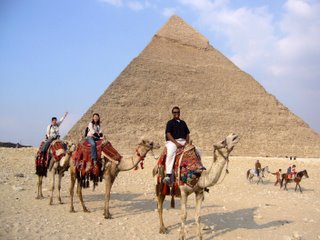
The following picture is yet another of both the biggest and 2nd biggest pyramids in the world (Khufu's & Khafre's pyramids). FYI, there are 9 pyramids in Giza.

The picture below is the pyramids of Menkaure with 3 sattelite pyramids of Menkaure, i cant seem to recollect what the Sat. Pyramids are, if i'm not i mistaken its for the queens.

This is the ancient boat used to carry the King Khafre on the nile river to the toomb here on the pyramids!

The found it in the burial chamber below (picture linked to external site). Dug it up and put it back togather to form the above boat. Amazing to know this pieces of wood lasted 1000 over years.

The following picture i think is labelled as 's' in the above picture, which is the central mastaba field. Mastaba is pretty much like graveyard, and if i'm not mistaken this was for either the nobles or the craftsman that built the pyramids.

So, if you have been following the plan, we will be reaching the valley temple of khafre next, where the king's body will be prepared for mummification. Beofre that, more picture of us on the camel and our camel guide on the phone :) . What an irony, pyramids, dessert, camels PLUS MOBILE PHONES! Thanks to vodaphone, and their network supplier ERICSSON :D.

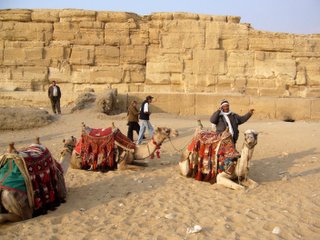 I'm skipping the valley temple pics, borin :). Now for the dessert, here's Mr Sphynx. I never really got a good shot at it, due to the crowd around the platform.
I'm skipping the valley temple pics, borin :). Now for the dessert, here's Mr Sphynx. I never really got a good shot at it, due to the crowd around the platform.
 The below picture was taken from inside Pizza hut, which is right opposite Sphynx, again, what an irony of old meet new. as you can see from this picture, there is a platform beside the Sphynx which is actual "h" in the above picture, khafre causeway, to take the mummified body from the valley temple to the toomb beneath the pyramid.
The below picture was taken from inside Pizza hut, which is right opposite Sphynx, again, what an irony of old meet new. as you can see from this picture, there is a platform beside the Sphynx which is actual "h" in the above picture, khafre causeway, to take the mummified body from the valley temple to the toomb beneath the pyramid.
Finally, a sunset picture. This was taken outside the Giza complex, infront of pizza hut. You see the Sphynx, cuaseway, Khafre's pyramid and Khufu's on the back.

COMING SOON: SOUND AND LIGHT SHOW @ GIZA

 We had a meeting with the global account managers and one of our country President for the respective account i'm currently working with, early February. The aim was to strategise how we're gonna handle an upcoming biggie with a customer. It was a good experiance for me, to see how meetings with CEO's and CTO's are handled, in a technical & comercial point of view. A small shrimp, in a big frying pan!
We had a meeting with the global account managers and one of our country President for the respective account i'm currently working with, early February. The aim was to strategise how we're gonna handle an upcoming biggie with a customer. It was a good experiance for me, to see how meetings with CEO's and CTO's are handled, in a technical & comercial point of view. A small shrimp, in a big frying pan! Me and Ehab, my team-ie from cairo (Above). Sweden is AWSOME and i must say that is an understatement. No doubt the weather was cold like crazy, i fell in love with the country within a few days being there. There is so much calm and peace everywhere. It was my first time touching snow, was so funny! Let the picture do the talking now!!
Me and Ehab, my team-ie from cairo (Above). Sweden is AWSOME and i must say that is an understatement. No doubt the weather was cold like crazy, i fell in love with the country within a few days being there. There is so much calm and peace everywhere. It was my first time touching snow, was so funny! Let the picture do the talking now!!


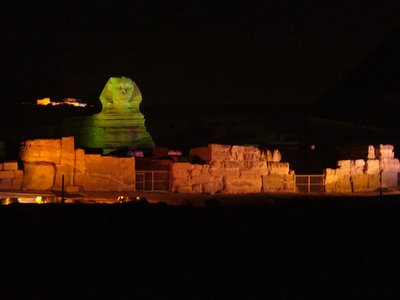
 My hands were shivering, freezing cold. So you get one of those overexposed images like above.
My hands were shivering, freezing cold. So you get one of those overexposed images like above. Khufu & Khafre's pyramids with light shining on them. Finally, one with blue shades below!
Khufu & Khafre's pyramids with light shining on them. Finally, one with blue shades below!






 The found it in the burial chamber below (picture linked to external site). Dug it up and put it back togather to form the above boat. Amazing to know this pieces of wood lasted 1000 over years.
The found it in the burial chamber below (picture linked to external site). Dug it up and put it back togather to form the above boat. Amazing to know this pieces of wood lasted 1000 over years. 


 I'm skipping the valley temple pics, borin :). Now for the dessert, here's Mr Sphynx. I never really got a good shot at it, due to the crowd around the platform.
I'm skipping the valley temple pics, borin :). Now for the dessert, here's Mr Sphynx. I never really got a good shot at it, due to the crowd around the platform. The below picture was taken from inside Pizza hut, which is right opposite Sphynx, again, what an irony of old meet new. as you can see from this picture, there is a platform beside the Sphynx which is actual "h" in the above picture, khafre causeway, to take the mummified body from the valley temple to the toomb beneath the pyramid.
The below picture was taken from inside Pizza hut, which is right opposite Sphynx, again, what an irony of old meet new. as you can see from this picture, there is a platform beside the Sphynx which is actual "h" in the above picture, khafre causeway, to take the mummified body from the valley temple to the toomb beneath the pyramid.




 The following picture is taken from direction no 4 from the map.
The following picture is taken from direction no 4 from the map. 


 To the north of the pyramid of Teti is the mastaba's (toombs/burial chamberf) of of Mereruka,
To the north of the pyramid of Teti is the mastaba's (toombs/burial chamberf) of of Mereruka, Right Side view of the Tomb of kagemni:
Right Side view of the Tomb of kagemni: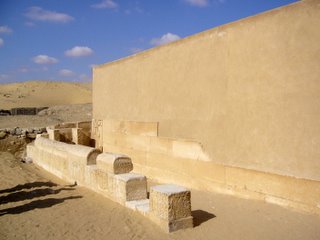 Left angle of the toomb for mereruka. The below picture is the entrance of the mastaba for Mereruka. The other 2 mastaba's are not open for tourist. You are also not allowed take pictures inside for fear of the camera flash spoiling the nice drawings.
Left angle of the toomb for mereruka. The below picture is the entrance of the mastaba for Mereruka. The other 2 mastaba's are not open for tourist. You are also not allowed take pictures inside for fear of the camera flash spoiling the nice drawings.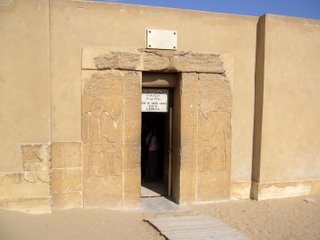
 This is the first of my serious of my travelogues, to share my travel experiences in Egypt. There are various areas of interest in Egypt that a tourist would want to visit and they are scattered around. Typically one would spend 2 days in Cairo, 3 the most. While in Cairo, the typical tours you might get hitched on is the following:
This is the first of my serious of my travelogues, to share my travel experiences in Egypt. There are various areas of interest in Egypt that a tourist would want to visit and they are scattered around. Typically one would spend 2 days in Cairo, 3 the most. While in Cairo, the typical tours you might get hitched on is the following: This is called a cartouche, which is pretty much a rubber stamp of the Kings ID. The hieroglyphics on the cartouche means something and every king in the ancient world had one. It was reported that whena new king took over, he went around statues of previous kings to erase their cartouche, to make the present king look supreme.
This is called a cartouche, which is pretty much a rubber stamp of the Kings ID. The hieroglyphics on the cartouche means something and every king in the ancient world had one. It was reported that whena new king took over, he went around statues of previous kings to erase their cartouche, to make the present king look supreme.
 This is just the cover, inside it is hollow and it will be slid ontop of another granite piece. Inside that granite piece lies the mummified body. The coffin will then be placed in what’s called the sarcophagus, which in lay man terms is a BIGGER COFFIN made out of solid rock!
This is just the cover, inside it is hollow and it will be slid ontop of another granite piece. Inside that granite piece lies the mummified body. The coffin will then be placed in what’s called the sarcophagus, which in lay man terms is a BIGGER COFFIN made out of solid rock!

